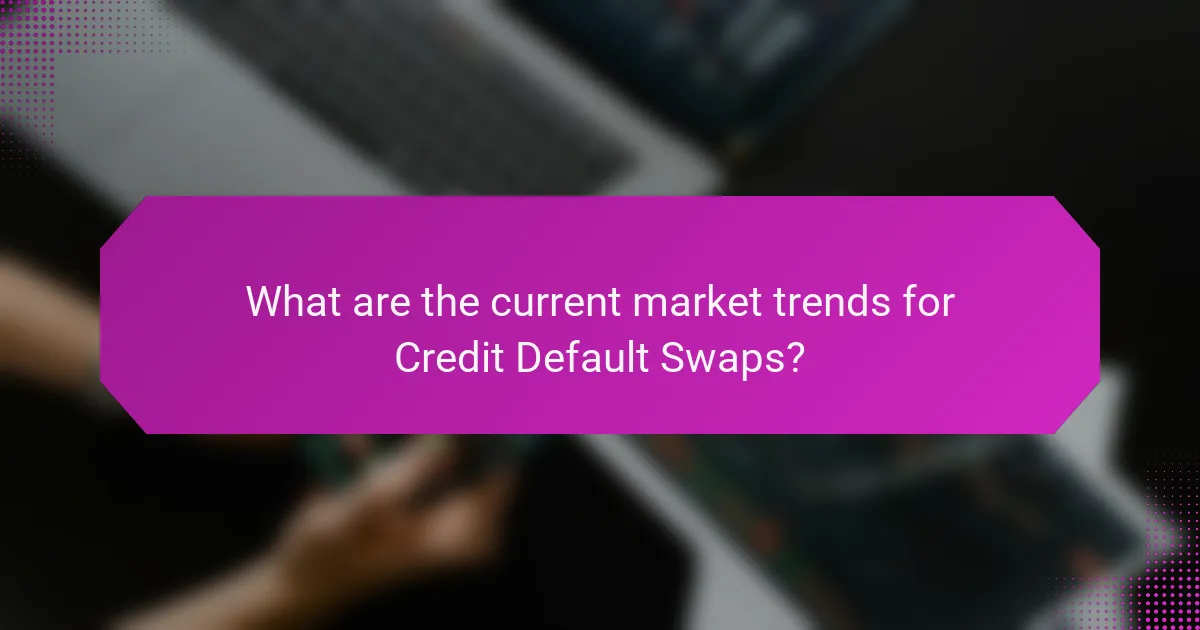Credit Default Swaps (CDS) are financial derivatives that enable investors to transfer credit risk associated with borrowers. This article examines the mechanisms of CDS, including how they function as a hedge against potential defaults and the associated costs. It also highlights the various risks involved, such as counterparty, market, liquidity, and regulatory risks, emphasizing their implications for financial stability. Current market trends indicate a growing demand for CDS, driven by rising credit risks and increased trading activity, particularly in emerging markets. The article provides insights into how regulatory changes are shaping the CDS landscape and affecting investor strategies in an evolving financial environment.

What are Credit Default Swaps?
Credit default swaps (CDS) are financial derivatives that allow an investor to “swap” or transfer the credit risk of a borrower. In a CDS contract, the buyer pays a premium to the seller in exchange for compensation in the event of a default. This mechanism helps protect against potential losses from credit events like bankruptcy or debt restructuring. The market for CDS has grown significantly, with a notional value exceeding $10 trillion as of 2021. CDS can be used for hedging or speculative purposes, impacting overall market stability. Their complexity and risk have led to regulatory scrutiny, especially following the 2008 financial crisis.
How do Credit Default Swaps function in financial markets?
Credit default swaps (CDS) are financial derivatives that allow investors to hedge against credit risk. They function as contracts where one party pays a premium to another in exchange for compensation if a specified credit event occurs. This credit event typically includes defaults or bankruptcies of the underlying asset, such as bonds or loans.
In a CDS agreement, the buyer of the swap seeks protection against the risk of default. The seller of the swap assumes this risk and receives periodic payments from the buyer. If a default occurs, the seller compensates the buyer for the loss, which is usually the difference between the face value of the debt and its recovery value.
CDS play a significant role in financial markets by enabling risk management and price discovery. They provide liquidity and can influence the creditworthiness of entities by reflecting market perceptions of risk. The global CDS market was valued at approximately $10 trillion in notional amounts as of 2021, highlighting their importance in financial systems.
What are the key components of a Credit Default Swap?
A Credit Default Swap (CDS) consists of several key components. The first component is the reference entity, which is the underlying borrower whose credit risk is being transferred. The second component is the protection buyer, who pays a premium to transfer the risk of default. The third component is the protection seller, who receives the premium and assumes the risk of default.
Another key component is the notional amount, which represents the value of the underlying debt being insured. The contract also includes the maturity date, which defines the duration of the swap agreement. Additionally, there are specific terms related to credit events, such as default or bankruptcy, that trigger the protection payout.
These components work together to create a financial instrument that allows investors to hedge against credit risk. CDS contracts are often used in the financial markets to manage exposure to credit risk effectively. The market for CDS has grown significantly, with the notional amount of outstanding contracts reaching over $10 trillion in recent years.
How do counterparties interact within a Credit Default Swap?
Counterparties in a Credit Default Swap (CDS) interact through a contractual agreement. One counterparty, known as the protection buyer, pays periodic premiums to the other, the protection seller. This exchange occurs in exchange for a promise to compensate the buyer in case of a credit event, such as default. The protection seller assumes the credit risk of the underlying asset, typically a bond or loan.
Both parties engage in negotiations to establish terms, including premium amounts and duration. The CDS contract specifies the reference entity, which is the borrower whose default triggers the swap. Market participants use CDS to hedge against credit risk or to speculate on credit quality.
In 2021, the global CDS market was valued at approximately $10 trillion, highlighting its significance. This interaction allows counterparties to manage risk and capital more effectively in financial markets.
What are the primary purposes of Credit Default Swaps?
Credit Default Swaps (CDS) serve primarily as a form of insurance against credit risk. They allow investors to hedge against the possibility of default on debt securities. Investors purchase CDS to transfer the risk of default to another party. This mechanism enhances liquidity in the credit markets. CDS can also be used for speculative purposes. Traders may buy CDS to profit from anticipated changes in credit quality. Additionally, they provide a means for price discovery in the credit markets. The CDS market was valued at approximately $10 trillion in 2021, highlighting its significance.
How do Credit Default Swaps provide risk management solutions?
Credit Default Swaps (CDS) provide risk management solutions by transferring credit risk from one party to another. They act as insurance against the default of a borrower. In a CDS contract, the buyer pays a premium to the seller. In return, the seller agrees to compensate the buyer if the borrower defaults. This mechanism allows investors to hedge against potential losses. By using CDS, financial institutions can manage exposure to credit risk effectively. As of 2023, the CDS market has grown significantly, indicating its importance in risk management strategies. Data shows that the notional amount of CDS contracts reached over $10 trillion. This highlights their role in stabilizing financial systems by spreading risk.
What role do Credit Default Swaps play in speculation?
Credit Default Swaps (CDS) facilitate speculation by allowing investors to bet on the creditworthiness of entities. They serve as insurance against defaults, enabling traders to profit from changes in credit risk. Investors can buy CDS contracts to speculate on a decline in the credit quality of a borrower. Conversely, they can sell CDS to profit from perceived stability in credit quality. The market for CDS can amplify speculation, as high trading volumes lead to price fluctuations. During the 2008 financial crisis, CDS were heavily used for speculation, contributing to market volatility. This highlights their dual role as risk management tools and speculative instruments.

What are the risks associated with Credit Default Swaps?
Credit Default Swaps (CDS) carry several risks. The primary risk is counterparty risk, where the seller may default on their obligations. This risk is significant because it can lead to substantial financial losses for the buyer. Market risk is another concern, as changes in market conditions can affect the value of CDS contracts. Additionally, liquidity risk exists, making it challenging to sell CDS positions without incurring losses. Regulatory risk is also relevant, as changes in regulations can impact the functioning of the CDS market. Historical instances, such as the 2008 financial crisis, illustrate the potential for systemic risk associated with widespread use of CDS. These risks highlight the complexities and dangers involved in trading Credit Default Swaps.
How can Credit Default Swaps lead to systemic risk?
Credit Default Swaps (CDS) can lead to systemic risk by creating interconnected financial exposures among institutions. These derivatives allow investors to speculate on or hedge against the default of borrowers. When multiple entities hold CDS on the same reference entity, a default can trigger widespread losses. This situation can lead to a liquidity crisis if institutions are unable to cover their obligations.
Additionally, the lack of transparency in the CDS market can obscure the true level of risk. In 2008, the collapse of Lehman Brothers highlighted how interconnected CDS positions contributed to the financial crisis. The resulting panic caused a loss of confidence in financial institutions, exacerbating systemic risk. Thus, CDS can amplify financial instability through their complex interdependencies and opaque nature.
What are the potential consequences of default in a Credit Default Swap?
The potential consequences of default in a Credit Default Swap (CDS) include financial loss for the protection buyer and increased systemic risk. When a reference entity defaults, the CDS seller must compensate the protection buyer, typically through a cash settlement. This settlement is often based on the difference between the face value and the recovery rate of the defaulted asset. The seller may face significant financial strain, impacting their liquidity and creditworthiness. Additionally, defaults can lead to a loss of confidence in the financial system. This can trigger broader market volatility and potential contagion effects across linked entities. Historical data shows that significant defaults can lead to cascading failures in interconnected financial institutions. For instance, the 2008 financial crisis highlighted how CDS defaults contributed to widespread market instability.
How does counterparty risk manifest in Credit Default Swaps?
Counterparty risk in Credit Default Swaps (CDS) manifests as the potential default of one party involved in the agreement. This risk arises because CDS are contracts between two parties, where one party pays a premium in exchange for a guarantee against default on a bond or loan. If the seller of the CDS defaults, the buyer may not receive the promised payout. Historical events, such as the 2008 financial crisis, highlighted this risk when major financial institutions faced insolvency. During that crisis, counterparty risk led to significant losses for investors relying on CDS for protection. The interconnectedness of financial institutions exacerbates this risk, as the failure of one can impact others in the network. Thus, counterparty risk is a critical concern in the CDS market, influencing pricing and market stability.
What regulatory measures exist for Credit Default Swaps?
Regulatory measures for Credit Default Swaps (CDS) include oversight by financial authorities. The Dodd-Frank Act established key regulations in the United States. This act mandates that CDS transactions be cleared through central counterparties. It also requires reporting of trades to swap data repositories. The European Market Infrastructure Regulation (EMIR) applies similar rules in Europe. EMIR emphasizes risk mitigation and transparency for OTC derivatives, including CDS. Additionally, Basel III regulations impose capital requirements for banks dealing with CDS. These measures aim to reduce systemic risk and enhance market stability.
How have regulations evolved since the financial crisis?
Regulations have significantly evolved since the financial crisis of 2008. The Dodd-Frank Wall Street Reform and Consumer Protection Act was enacted in 2010 in response to the crisis. This act aimed to increase transparency and reduce risks in the financial system. It introduced measures such as the Volcker Rule, which restricts proprietary trading by banks. Additionally, it established the Consumer Financial Protection Bureau to oversee financial products and protect consumers. The Basel III framework was also implemented, requiring banks to hold more capital and improve risk management practices. These regulatory changes aim to prevent future financial instability and protect the economy.
What are the implications of current regulations on market participants?
Current regulations significantly impact market participants in the credit default swaps (CDS) market. They introduce compliance requirements that affect trading strategies and operational costs. Market participants must adapt to increased transparency mandates. This includes reporting trades and positions to regulatory authorities. The regulations also aim to reduce systemic risk, influencing how participants manage their portfolios. For instance, central clearing requirements shift risk management practices. Additionally, regulations can limit the types of entities that can participate in the market. This can lead to reduced liquidity and higher costs for end-users. Overall, these regulations shape market dynamics and participant behavior.

What are the current market trends for Credit Default Swaps?
The current market trends for Credit Default Swaps (CDS) indicate increased demand due to rising credit risks. As of late 2023, CDS spreads have widened significantly, reflecting concerns about potential defaults in various sectors. Financial institutions are actively utilizing CDS as a hedge against credit exposure. Additionally, the market has seen a surge in trading volume, driven by heightened volatility in underlying credit markets. Regulatory changes are also influencing CDS market dynamics, promoting transparency and standardization. Investors are increasingly focusing on emerging market CDS, seeking opportunities amid global economic uncertainties. Overall, these trends suggest a growing reliance on CDS for risk management in an unpredictable financial landscape.
How have market dynamics changed in recent years?
Market dynamics have shifted significantly in recent years due to increased volatility and regulatory changes. The rise of digital trading platforms has enhanced market accessibility. Additionally, investor sentiment has become more sensitive to geopolitical events. The growth of algorithmic trading has altered traditional trading strategies. According to the International Swaps and Derivatives Association, the credit default swap market saw a 20% increase in trading volume in 2021. This reflects a heightened demand for risk management tools. Furthermore, the COVID-19 pandemic has accelerated shifts towards more remote trading environments. Overall, these factors have contributed to a more complex and rapidly changing market landscape.
What factors influence the pricing of Credit Default Swaps today?
The pricing of Credit Default Swaps (CDS) is influenced by several key factors. These include the creditworthiness of the underlying entity, which is assessed through credit ratings. A higher perceived risk of default leads to higher CDS premiums. Market liquidity also plays a crucial role; more liquid markets tend to have lower spreads. Economic conditions, such as interest rates and market volatility, affect investor sentiment and pricing. Additionally, regulatory changes can impact the CDS market dynamics. Historical default rates provide context for pricing adjustments. Lastly, supply and demand for protection against defaults can shift prices significantly.
How do macroeconomic conditions affect Credit Default Swap markets?
Macroeconomic conditions significantly influence Credit Default Swap (CDS) markets. Economic factors such as GDP growth, unemployment rates, and inflation impact credit risk perceptions. When the economy is strong, default risks decrease, leading to lower CDS spreads. Conversely, during economic downturns, default risks rise, increasing CDS spreads. For instance, during the 2008 financial crisis, CDS spreads widened dramatically due to heightened credit risk. Additionally, central bank policies, like interest rate changes, affect investor sentiment in CDS markets. Lower interest rates can lead to increased demand for CDS as a hedge against credit risk. Overall, macroeconomic indicators serve as vital signals for CDS market movements.
What future developments can be expected in the Credit Default Swap market?
Future developments in the Credit Default Swap (CDS) market include increased regulation and transparency. Regulators are likely to impose stricter rules following past financial crises. This aims to reduce systemic risk and enhance market stability. Technological advancements may also play a significant role. Blockchain technology could streamline settlement processes and improve efficiency. Additionally, the rise of ESG (Environmental, Social, Governance) factors may lead to new types of CDS products. These products would cater to sustainability-focused investors. Increased market participation from institutional investors is expected as well. This reflects a growing acceptance of CDS as a hedging tool. Overall, the CDS market is poised for significant evolution in response to regulatory, technological, and market dynamics.
How might technological advancements impact Credit Default Swaps?
Technological advancements may enhance the efficiency and transparency of Credit Default Swaps (CDS). Innovations such as blockchain can streamline transactions and reduce counterparty risk. Automated trading systems can facilitate faster execution and pricing of CDS contracts. Machine learning algorithms can improve risk assessment and default prediction. These technologies can also provide real-time data analytics for better decision-making. Historical data shows that increased transparency leads to lower spreads in CDS markets. Enhanced technology may attract more participants, increasing liquidity and market stability. Overall, technology can significantly reshape the CDS landscape by improving operational efficiency and risk management.
What trends should investors watch for in the coming years?
Investors should watch for increased regulatory scrutiny on credit default swaps (CDS). Recent trends indicate a push for transparency and risk management in the CDS market. The Financial Stability Oversight Council has highlighted concerns about systemic risks associated with derivatives. Additionally, the rise of technology in trading platforms is reshaping how investors engage with CDS. Digitalization may enhance efficiency and reduce costs. Furthermore, ESG (Environmental, Social, Governance) factors are becoming more significant in investment decisions. Investors are increasingly considering the sustainability of their portfolios. Lastly, market volatility is expected to persist, influencing CDS pricing and risk appetite. Historical data shows that economic downturns often lead to spikes in CDS usage as hedging instruments.
What best practices should be followed when engaging with Credit Default Swaps?
Engaging with Credit Default Swaps (CDS) requires adherence to several best practices. First, conduct thorough credit analysis of the underlying reference entity. This analysis should include financial health, credit ratings, and market conditions. Second, ensure clear understanding of the CDS contract terms. This includes premium payments, maturity dates, and triggers for default. Third, maintain proper documentation and record-keeping. Accurate records help in compliance and dispute resolution. Fourth, diversify CDS positions to mitigate risk. Diversification reduces exposure to any single entity’s default. Fifth, monitor market trends and regulatory changes. Staying informed helps in making timely decisions. Lastly, engage with reputable counterparties. This reduces counterparty risk and enhances transaction security. Following these practices can lead to more informed and secure engagement with Credit Default Swaps.
Credit Default Swaps (CDS) are financial derivatives that enable investors to manage credit risk by transferring the potential for loss from defaults or bankruptcies. This article provides a comprehensive overview of CDS, detailing their mechanisms, key components, and the roles they play in risk management and speculation. It also examines the associated risks, including counterparty and market risks, alongside regulatory measures that have evolved since the 2008 financial crisis. Current market trends, pricing factors, and future developments in the CDS landscape are discussed, offering insights for investors on best practices and emerging dynamics in this critical financial instrument.
